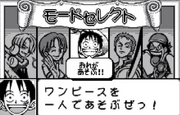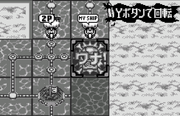One Piece: Become the Pirate King! is a turn-based strategy game for the handheld WonderSwan console, loosely adapting the events of the East Blue Saga (along with One Piece: The Movie). Designed by Soft Machine and published by Bandai, it was released on July 19, 2000—the first official video game under the One Piece license.
Following the game's release, five more One Piece games would be produced for WonderSwan consoles, though Become the Pirate King! remains the only one compatible with the original monochromatic system.
Gameplay[]
The game mainly revolves around path-building, with players laying tiles across various sea maps. The piecemeal paths depicted on these tiles must be connected so players can reach objectives such as islands and enemy crews.
Tiles come in four basic path formations—straights, elbows, T's, and crosses—that can be rotated clockwise or counterclockwise in 90-degree intervals. A path's permanence is determined by its colors: white paths can be replaced by new ones, but dark paths cannot.
Players are limited to a pool of five tiles at any given time. After a tile has been laid, its successor must be chosen from a randomly shuffled "deal" of five new tiles.
Exploration[]

A typical exploration turn. Note the banner keeping track of available movement points.
Exploration mainly relies on the Move (移動, Ido?) command, which opens the player's current tile pool and (if applicable) replacement shuffle. One tile must be laid every turn, though it need not be connected or even adjacent to any other tiles.
After laying the tile, the player will be granted a jolly roger marker to plot their destination, and a number of movement points equal to the number on the tile; each rivet on a path costs one movement point to cross. Once the destination is set, the player will automatically sail there, ending the current turn.
Note that left-over movement points cannot be carried between turns; every new turn will start with zero movement points.
Combat[]

A typical combat turn, with Nami on the attack. Note the Hit Point displays.
Combat employs many of the same tile mechanics as exploration. Players may field a maximum of three combatants, and lay up to three tiles per round.
The combat map proper is a 3x3 grid, with the battling crews on opposite ends. The top and bottom rows of this grid are pre-laid with identical paths; to reach the enemy, each side must build a functional path through the middle row. While movement points do not exist in combat, the numbers on the tiles are still vital for determining initiative; whichever side compiles the higher sum lays—and attacks—first.
Once the tiles are laid, the combatants will move according to their lineup positions: the rightmost character will take the rightmost route, the leftmost character the leftmost route, and the center character the center route. This lineup may be reordered at the start of every round, alongside tile selection.
Each character is assigned a Type (タイプ, Taipu?), which governs their attack capabilities:
- Melee (近距離?) types, such as Zoro, must reach the far row to attack. On reaching the far row, they will attack the character in the closest square; if this square is unoccupied, they will attack the enemy ship instead.
- Ranged (遠距離?) types, such as Usopp, must stop at the middle row to attack. Unlike Melee types, they can only attack the enemy ship.
- All-Rounder (万能?) types, such as Luffy, may employ both Melee and Ranged attacks.
Combat performance relies on the following attributes:
- Offense (攻撃力?), which determines the "raw" damage dealt by a successful attack.
- Defense (守備力?), which determines the damage deducted from an enemy attack; if high enough, it can completely nullify an attack.
- Agility (素早さ?), which determines what order a given side's combatants will attack in.
In addition, every character has several Finisher (必殺, Hissatsu?) attacks tied to unique path formations—Luffy, for instance, will perform a Gomu Gomu no Bazooka if facing a cross between two vertical straights. A successful finisher will always deal a fixed amount of damage to every enemy combatant and ship, but also lock any allies out of attacking until the next round.
A combat is won when the enemy crew has lost every member, or their ship.
Playable Characters[]
There are thirty-six playable characters, comprising almost every notable figure from the East Blue Saga.
Items[]
Players may obtain a number of different Items (道具, Dōgu?) from combat victories and other significant events. These are stored in a default inventory, to be used—or discarded—at any time outside combat.
| Item | Effect |
|---|---|
| Mikan (ミカン?) |
Restores 10 HP to one chosen character. |
| Raw Ham Melon (生ハムメロン?) |
Restores 15 HP to one chosen character. |
| Bean Stirfry (もやし炒め?) |
Restores 20 HP to one chosen character. |
| Riceball (おむすび?) |
Restores 25% of maximum HP to one chosen character. |
| Drumstick (骨付き肉?) |
Restores 50% of maximum HP to one chosen character. |
| Pirate Bento (海賊弁当?) |
Restores full HP to one chosen character. |
| Lumber (木材?) |
Restores 30 HP to the ship. |
| Steel (鋼材?) |
Restores 50 HP to the ship. |
(Note that the inventory can hold a maximum of ten items.)
Game Modes[]

Top Menu. Each Straw Hat marks a different mode (save Usopp, who marks the Options menu).
Four different modes may be accessed from the Top Menu, including several multiplayer modes able to support up to four players.
Note that none of the multiplayer modes support play via the WonderSwan's link-cable system. Instead, a single WonderSwan console must be passed back and forth between players.
Solo[]
The Solo (おれがあそぶ, Ore ga isobu?, lit. "I'll play") mode adapts the Straw Hat Pirates' East Blue adventures into six levels of exploration and combat. Each level contains a mixture of combat and racing missions, interspersed with scenes and dialogue adapted directly from the manga.
After a level has been cleared, it may be played again any number of times. Most enemies can be unlocked as playable characters if a re-play of their level is cleared within a set number of turns.
| Level | Characters * | |
|---|---|---|
| Dialog | Enemy | |
| Morgan Arc (モーガン編?) |
||
| Buggy Arc (バギー編?) |
||
| Black Cat Arc (クロネコ編?) |
||
| Krieg Arc (クリーク編?) |
||
| Arlong Arc (アーロン編?) |
|
|
| Loguetown Arc (ローグタウン編?) |
|
|
Clearing these six levels will complete Solo mode, and unlock a bonus level adapting One Piece: The Movie.[3]
| Level | Characters | |
|---|---|---|
| Dialog | Enemy | |
| Eldoraggo Arc (エルドラゴ編?) |
||
Multi-Player[]
The Multi-Player (みんなであそぶ, Min'na de asobu?, lit. "everyone plays") mode allows players to assemble custom crews and race each other across eight separate maps. Its combat and sailing mechanics are mostly identical to those of Solo mode, although players cannot see enemy ships until they occupy adjacent tiles. Combat initiates whenever two ships meet on the same tile, and is limited to one round in all circumstances.
In addition, this mode may occasionally offer Special (特殊?) tiles that offer no paths or movement points, instead laying traps or exercising other effects on the sailing map:

Rock, King, and Whirlpool tiles fall under the Trap (ワナ?) category, and can be laid over any sea-path. They are invisible on all enemy turns.
- Tailwind (追風?) tiles double the movement points on the next two tiles the player lays.
- Headwind (向風?) tiles halve the movement points on the next two tiles every opponent lays (rounding up for odd values).
- Cannon (砲?) tiles allow the player to shoot one tile within a 5x5 area, destroying any path it contains; any player occupying the shot tile will be capsized, skipping their next turn.
- Rock (岩?) tiles capsize the first crossing player, skipping their next turn.
- King (王?) tiles ambush the first crossing player with a Sea King, skipping their next turn.
- Whirlpool (渦?) tiles warp the first crossing player to a random point on the map.
All support and trap tiles can also be laid on the combat map, inflicting a flat amount of damage on the first character to cross.
Mini-Games[]
Reaching any of the checkpoint islands scattered throughout the Multi-Player maps will prompt one of three mini-games.
- Big-Eater Blowout (大食い競��, Ōkui kyōsō?), which randomly selects one character from each player's crew to compete in a Baratie eating contest. Each competitor has 30 seconds to grab as many dishes as possible (taking care to avoid those contaminated by flies).
- Mihawk's Diversion (ミホークのひまつぶし, Mihawk no himatsubushi?), which randomly selects one character from each player's crew to battle Mihawk. Competitors take turns attacking Mihawk under a set of nim-like conditions, trying to maneuver each other into making the final attack.
- High-Seas Showdown (海上大決戦, Kaijō daisakusen?), which pits every player's crew against a combined assault from Fullbody, Nezumi, and Pudding Pudding. Competitors take turns shooting a fleet of thirty Marine ships, trying to sink them all before any can reach a designated "dead line".
Hyper Battle[]
An electronic adaptation of the Carddass Hyper Battle system attached to the official One Piece card game. Supports up to four players.
Strongest Pirate Challenge[]
The Strongest Pirate Challenge (最強海賊決定戦, Saikyō kaizoku kettei-sen?) allows players to wage team battles in an alternative, more RPG-esque environment.
In this mode, the player must build (and name) a crew of three custom characters. Each character is allotted 100 points, to be distributed among their Offense, Defense, and Agility attributes. Rather than set Types, characters must be assigned to one of six Classes, each with a unique specialty:
In addition, each crew must choose a companion from a pool of thirteen canon characters (Luffy, Zoro, Nami, Usopp, Sanji, Alvida, Morgan, Buggy, Kuro, Krieg, Arlong, Smoker, or Eldoraggo). These are not counted as crewmates proper, but will launch special attacks from the sidelines if certain conditions are met.
Once begun, combat proceeds automatically, requiring virtually no player input. All combatants carry a standardized amount of HP, and take turns exchanging attacks (with occasional allowances for companion attacks and other special effects). A defeated combatant is immediately replaced by the next member of their crew, until one of the two crews has successfully defeated every opponent.
Trivia[]
- The Solo mode depicts the Going Merry as Luffy's ship from the very beginning, rather than an acquisition from Syrup Village.
- On its initial release, the game's instruction booklet was packaged with six exclusive Carddass cards, all based on the game's box-art. One used the box-art directly, while the other five depicted the individual Straw Hat Pirates.
References[]
- ↑ Ripper's portrait stands in for several other minor Marines —such as Lines—in subsequent levels.
- ↑ Poppoko's portrait stands in for several other minor pirates—such as the Superhuman Domingos—in subsequent levels.
- ↑ Completing Solo mode will also cause a special "Panda Island" to be hidden inside every level, to be discovered on re-play. Discovering all seven Panda Islands will unlock Pandaman as a playable character.
External Links[]
- Official WonderSwan page (Japanese) (archived)
- WSC One Piece (Japanese fan-site)
[]
| |||||||||||||||||
| |||||||||||||||||
| |||||||||||||||||
| |||||||||||||||||

